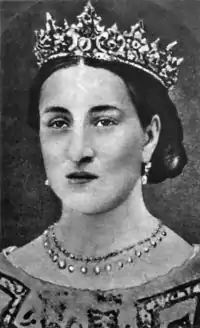Fatma Sultan (daughter of Abdulmejid I)
Fatma Sultan (Ottoman Turkish: فاطمه سلطان; 1 November 1840 – 26 August 1884) was an Ottoman princess, the daughter of Sultan Abdulmejid I and his sixth consort Gülcemal Kadın and the full sister of Sultan Mehmed V of the Ottoman Empire.
| Fatma Sultan | |||||
|---|---|---|---|---|---|
 | |||||
| Born | 1 November 1840 Beşiktaş Palace, Constantinople, Ottoman Empire (present day Istanbul, Turkey) | ||||
| Died | 26 August 1884 (aged 43) Baltalimanı Palace, Istanbul, Ottoman Empire | ||||
| Burial | |||||
| Spouse |
| ||||
| Issue |
| ||||
| |||||
| Dynasty | Ottoman | ||||
| Father | Abdulmejid I | ||||
| Mother | Gülcemal Kadın | ||||
| Religion | Sunni Islam | ||||
Early life
Fatma Sultan was born on 1 November 1840 in the Beşiktaş Palace. Her father was Sultan Abdulmejid I, and her mother was Gülcemal Kadın, a Bosnian. She was the second child and eldest daughter born to her father, and the eldest daughter born to her mother. She had a sister Refia Sultan, one year younger then her and a brother Mehmed V, four years younger then her.[1] After her mother's death in 1851, she and her siblings were adopted by Abdulmejid's first wife, Servetseza Kadın.[2][3]
In accordance with the custom, Fatma Sultan began to take lessons in the Quran in 1847, together with her sisters Refia Sultan, and Cemile Sultan, and brothers Murad V and Abdul Hamid II.[4]
First marriage
Engagement
When Fatma Sultan came of age, the sons of some of the most exalted personages aspired to the hand of the young princess. Mustafa Reşid Pasha and more especially his wife Adile Hanım, who was excessively proud, were particularly anxious that their son, Ali Galib Pasha, should become the Sultan's son-in-law. The other ministers wished to please the Grand vizier, and tried to induce their master to give the hand of the princess to the son of their colleague. After much pressing, the Sultan consented to the proposed union.[5]
Wedding
Abdulmejid first purchased Mustafa Reşid Paşa's palace and waterfront house in Baltalimani at a cost of 250,000 gold liras. He then gave freehold possession of these estates to his daughter Fatma Sultan, leaving the Pasha with a vast fortune to pay for the wedding expenses. Ali Galip Bey was appointed to Pasha's rank and made a member of the Meclis-i Vâlâ (Supreme Court).[6]
The marriage which coincided with the most fervent period of the Crimean War, took place on 7 August 1854 in the Çırağan Palace. The bridal procession of Fatma Sultan left this palace, and traveled with "pomp and circumstance" partly by land and partly by sea, conveying the bride to Baltalimanı Palace.[6][2] The wedding lasted seven days, and was consummated on 10 August.[7]
Issue
The next year she gave birth to a daughter, Cemile Hanımsultan, who died in infancy.[8]
Second marriage
After the death of Ali Galib Pasha in 1858 she married, Mehmed Nuri Pasha, son of Arif Pasha on 24 March 1859. The two had two children, Sultanzade Mehmed Fuad Bey and Emine Lütfiye Hanımsultan. Both of them died young.[9][10] Following the dubious conviction and exile to Arabia of her husband for complicity in the death of Sultan Abdulaziz, Fatma withdrew to her palace.[1] In 1878, she and her siblings including her brothers Prince Ahmed Kemaleddin, and Prince Selim Süleyman, and sister Seniha Sultan, were all involved in the Ali Suavi incident with the objective of restoring Murad to the throne.[11] She was widowed at his death in 1883.[12]
Death
Fatma died on 26 August 1884 at the age of forty three and is buried in the mausoleum of Sultan Murad V at the New Mosque, Istanbul.[9][13]
See also
Ancestry
| Ancestors of Fatma Sultan (daughter of Abdulmejid I) | |||||||||||||||||||||||||||||||||||||||||||||||||||||||||||||||||||||||||||||||||||||||||||||||||||||||||||||||||||||||||||||||||||||||||||||||||||||||||||||||||||||||||||||||||||||||||||||||||||||||||||||||||||||||||||||||||||||||||||||||||||||||||||||||||||||||||||||||||||||||||||||||||||||||||||||||||||||||||||||||||||||||||||||||||||||||||||||||||||||||||||||||||||||||||||||||||||||||||||||||||||||||||||||||||||||||||||||||||||||||||||||||||||||||||||||||||||
|---|---|---|---|---|---|---|---|---|---|---|---|---|---|---|---|---|---|---|---|---|---|---|---|---|---|---|---|---|---|---|---|---|---|---|---|---|---|---|---|---|---|---|---|---|---|---|---|---|---|---|---|---|---|---|---|---|---|---|---|---|---|---|---|---|---|---|---|---|---|---|---|---|---|---|---|---|---|---|---|---|---|---|---|---|---|---|---|---|---|---|---|---|---|---|---|---|---|---|---|---|---|---|---|---|---|---|---|---|---|---|---|---|---|---|---|---|---|---|---|---|---|---|---|---|---|---|---|---|---|---|---|---|---|---|---|---|---|---|---|---|---|---|---|---|---|---|---|---|---|---|---|---|---|---|---|---|---|---|---|---|---|---|---|---|---|---|---|---|---|---|---|---|---|---|---|---|---|---|---|---|---|---|---|---|---|---|---|---|---|---|---|---|---|---|---|---|---|---|---|---|---|---|---|---|---|---|---|---|---|---|---|---|---|---|---|---|---|---|---|---|---|---|---|---|---|---|---|---|---|---|---|---|---|---|---|---|---|---|---|---|---|---|---|---|---|---|---|---|---|---|---|---|---|---|---|---|---|---|---|---|---|---|---|---|---|---|---|---|---|---|---|---|---|---|---|---|---|---|---|---|---|---|---|---|---|---|---|---|---|---|---|---|---|---|---|---|---|---|---|---|---|---|---|---|---|---|---|---|---|---|---|---|---|---|---|---|---|---|---|---|---|---|---|---|---|---|---|---|---|---|---|---|---|---|---|---|---|---|---|---|---|---|---|---|---|---|---|---|---|---|---|---|---|---|---|---|---|---|---|---|---|---|---|---|---|---|---|---|---|---|---|---|---|---|---|---|---|---|---|---|---|---|---|---|---|---|---|---|---|---|---|---|---|---|---|---|---|---|---|---|---|---|---|---|---|---|---|---|---|---|---|---|---|---|---|---|---|---|---|---|---|---|---|---|---|---|---|---|---|---|---|---|---|---|---|---|---|---|---|---|---|---|---|---|---|---|---|---|---|---|---|---|---|---|---|---|---|---|---|---|---|---|---|---|---|---|---|
| |||||||||||||||||||||||||||||||||||||||||||||||||||||||||||||||||||||||||||||||||||||||||||||||||||||||||||||||||||||||||||||||||||||||||||||||||||||||||||||||||||||||||||||||||||||||||||||||||||||||||||||||||||||||||||||||||||||||||||||||||||||||||||||||||||||||||||||||||||||||||||||||||||||||||||||||||||||||||||||||||||||||||||||||||||||||||||||||||||||||||||||||||||||||||||||||||||||||||||||||||||||||||||||||||||||||||||||||||||||||||||||||||||||||||||||||||||
References
- Brookes 2010, p. 281.
- Uluçay 2011, p. 218.
- Sakaoğlu 2008, p. 604-5.
- Kolay 2017, p. 681.
- Hanim 1872, p. 235.
- Sakaoğlu 1992, p. 169.
- Sakaoğlu 2008, p. 608.
- Uluçay 2011, p. 219.
- Uluçay 2011, p. 219-20.
- Sakaoğlu 2008, p. 613-13.
- Brookes 2010, p. 76 and n. 51, 52.
- Sakaoğlu 2008, p. 612.
- Sakaoğlu 2008, p. 613.
Sources
- Brookes, Douglas Scott (2010). The Concubine, the Princess, and the Teacher: Voices from the Ottoman Harem. University of Texas Press. ISBN 978-0-292-78335-5.
- Hanim, Melek (1872). Thirty years in the harem: or, The autobiography of Melek-Hanum, wife of H.H. Kibrizli-Mehemet-Pasha.
- Kahya, Özge (2012). Sultan Abdülmecid’in kızı Mediha Sultan’ın hayatı (1856-1928).
- Kolay, Arif (2017). Osmanlı Saray Hayatından Bir Kesit: Ali Akyıldız ve Mümin ve Müsrif Bir Padişah Kızı Refia Sultan.
- Sakaoğlu, Necdet (2008). Bu mülkün kadın sultanları: Vâlide sultanlar, hâtunlar, hasekiler, kadınefendiler, sultanefendiler. Oğlak Yayıncılık. ISBN 978-9-753-29623-6.
- Sakaoğlu, Necdet (1992). National Palaces: Record of a Royal Wedding During the Tanzimat Period. TGNA Press, Ankara.
- Uluçay, Mustafa Çağatay (2011). Padişahların kadınları ve kızları. Ankara: Ötüken. ISBN 978-9-754-37840-5.
.svg.png.webp)